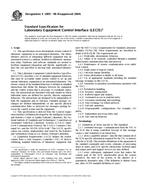1.1 This specification covers deterministic remote control of laboratory equipment in an automated laboratory. The labor-intensive process of integrating different equipment into an automated system is a primary problem in laboratory automation today. Hardware and software standards are needed to facilitate equipment integration thereby significantly reduce the cost and effort to develop fully automated laboratories.
1.2 This Laboratory Equipment Control Interface Specification (LECIS) describes a set of standard equipment behaviors that must be accessible under remote control to set up and operate laboratory equipment in an automated laboratory. The remote control of the standard behaviors is defined as standard interactions that define the dialogue between the equipment and the control system that is necessary to coordinate operation. The interactions are described with state models in which individual states are defined for specific, discrete equipment behaviors. The interactions are designed to be independent of both the equipment and its function. Standard message exchanges are defined independently of any specific physical communication links or protocols for messages passing between the control system and the equipment.
1.3 This specification is derived from the General Equipment Interface Definition developed by the Intelligent Systems and Robotics Center at Sandia National Laboratory, the National Institute of Standards Technologies’ Consortium on Automated Analytical Laboratory Systems (CAALS) High-Level Communication Protocol, the CAALS Common Command Set, and the NISTIR 6294 (1-4). This LECIS specification was written, implemented, and tested by the Robotics and Automation Group at Los Alamos National Laboratory.
1.4 Equipment Requirements-LECIS defines the remote control from a Task Sequence Controller (TSC) of devices exhibiting standard behaviors of laboratory equipment that meet the NIST CAALS requirements for Standard Laboratory Modules (SLMs) (5). These requirements are described in detail in Refs (3, 4). The requirements are:
1.4.1 Predictable, deterministic behavior,
1.4.2 Ability to be remotely controlled through a standard bidirectional communication link and protocol,
1.4.3 Maintenance of remote communication even under local control,
1.4.4 Single point of logical control,
1.4.5 Universal unique identifier,
1.4.6 Status information available at all times,
1.4.7 Use of appropriate standards including the standard message exchange in this LECIS,
1.4.8 Autonomy in operation (asynchronous operation with the TSC),
1.4.9 Perturbation handling,
1.4.10 Resource management
1.4.11 Buffered inputs an outputs,
1.4.12 Automated access to material ports,
1.4.13 Exception monitoring and reporting,
1.4.14 Data exchange via robust protocol,
1.4.15 Fail-safe operation,
1.4.16 Programmable configurations (for example, I/O ports),
1.4.17 Independent power-up order, and
1.4.18 Safe start-up behavior.
Product Details
- Published:
- 04/01/2004
- Number of Pages:
- 27
- File Size:
- 1 file , 400 KB
